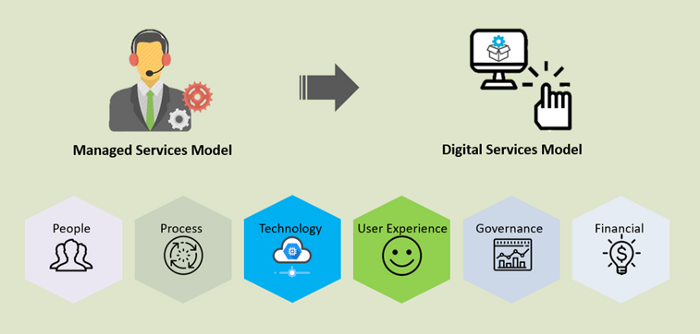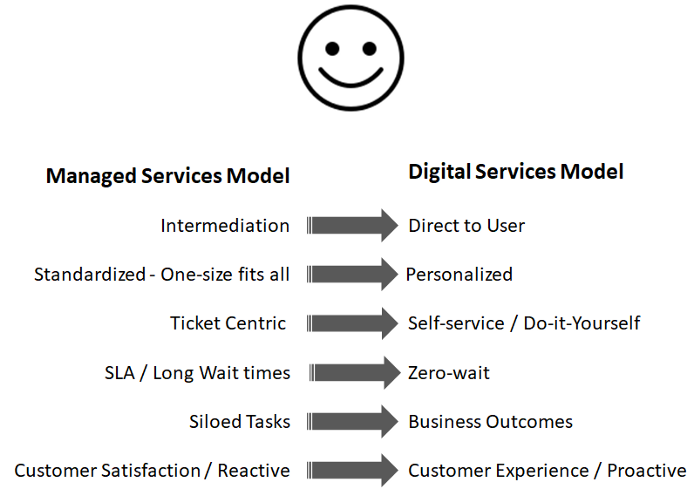Most Enterprises are stuck in a fixed cost model in this downturn. Their revenues and margins are shrinking drastically and their cost structure remains flat adding undue pressure on the CIOs. We believe service-centric approach is the solution and step ‘Zero’ of your Digital transformation journey. Design for Experience and Pay for successful outcomes.

This is a multi-part series on Digital Service Model. In the last 2 blogs, we looked at what is Digital Service Model and how does it impact Enterprises. This is a continuation of our earlier blog. Please check them out to get a better context.
In the previous blog we looked at how Digital Service Model impacts People, Process and Technology. In this blog, we look through the lens of Customer Experience, Governance and Financial models.

i) Enterprises will move from an intermediated (‘Man in the middle’) model to a direct-to-user model. Currently Enterprise Service Delivery is non-standard and requires lot of decision making. In Digital service model, Enterprises need to productize their services where they are highly standardized in the backend and can be customized at the point of consumption. It enables them to eliminate the middleman and offer services to their users directly.
ii) Enterprises today are ‘one-size fits all’ world. Services today are merely focused on delivering tasks and not driving Experience. In Digital Age, users are looking for flexibility and choice to customize services to their needs. Productized delivery model is user-centric, helps you to design persona based services and enables consumer grade experience through flexibility and choice.
User Experience is the center of the Digital world
iii) The ticket centered world will move into a self-service (DIY) world. In digital service model, users want their services here and now. To enable this shift, services need to be a lot more simplified and enabled in an easy way for users to consume. If the services designed are very technical and complex so as to require effort and skill from users, the adoption of the new model will drop drastically.
iv) Enterprises are very siloed today — teams are siloed, apps & tools are siloed, processes are siloed. These make the Enterprises very inward focused leading to sub optimal user experience. In Digital world, users want outcomes delivered instantly. Instead of providing discrete tasks, Enterprises need to look at the broader picture, create integrated cross-functional services and deliver outcomes at a click.
v) The fundamental premise of SLA is to ensure predictability, but this also means that users have to wait to get their services delivered. The more complex the service, longer the wait time. In digital age, speed is key. Driving higher levels of automaton enables ‘Zero-Wait’, where users can order services and get them delivered instantly.
vi) Customer Satisfaction today is a very reactive measure. The very fact that a user is reaching out to a support team, means that a customer satisfaction issue has occurred — how efficiently you deliver, or you resolve is beside the point. In Digital Service model, the focus is more on eliminating the need for support. Services are designed and architected to be zero-touch, zero-wait and can be consumed easily as self-service.
Anytime, anywhere, anytime, personalized to your needs and delivered instantly — This is the core philosophy of Digital Service Model

i) The traditional concept of Service Management, ticket-centered delivery governance etc., are designed for people centred world and are becoming less relevant in digital realm. In order to deliver experience, Enterprises need to shift their focus on Design and Engineering. This follows a product management rhythm.
In Digital Age, Service is the new Product.
Enterprises will move into the world of product management, hire new roles in the form of of product managers, who will handle different portfolios.
ii) The traditional governance takes corrective /preventive actions based on metrices , but these are mostly reactive in nature or captured/analysed after the fact. While these are useful, digital world offers a far superior alternative. We will have tools that are integrated tightly to provide real-time dashboards with insights and intelligence to help manage these services more efficiently and effectively. These are more predictive mechanisms enabling faster and smarter decisions.
iii) Currently the governance is focused on Service Delivery. In Digital age, where lot of Enterprises services are zero-touch, most of their current governance mechanisms will be ineffective. The new governance mechanism needs to focus on defining Enterprise standards for service design and architecture, creating integrated cross-functional services , service lifecycle management, user experience management etc.
Consumption Economics is an 800-pound gorilla in the digital world.
As you move into as a service economy, larger part of spend will become variable. Enterprises need necessary tools and processes to manage and govern their consumption and spend to avoid the risk of overshooting budgets. They need to invest in robust consumption economics processes and tools.

i) Today lot of Enterprises consume services in a traditional fixed cost structure and inflexible contracts — T&M, fixed bid etc., While some providers offer utility pricing (per call, per server etc.,) it comes with a minimum commitment. In times such as these, Enterprises are caught between shrinking budgets on one side and the fixed costs on the other.
Being truly digital means you are in a Pay-as-you-go world, where you pay only for what you use
In Digital Services, the entire model will move into an outcome based pricing. Enterprises are shifting their fixed cost structure on hardware & software to variable cost structure by moving to cloud. In the same way, their labor/services component will also move to cloud, where they subscribe to services at a click and pay for what they use.
Services are the next realm for Subscription-economy
And in conclusion, as we wrap up our thoughts on Digital Services Model, an important question comes to mind. Will Digital Service model replace Managed Service model? Eventually yes, but this is a long drawn journey. Both the models will co-exist for a foreseeable future. We will see a bimodal Service Delivery where both Legacy and Digital Services will coexist. We expect this to be a multi-year /decadal transition.

With Covid, we see a significant interest in Digital adoption across all Enterprises globally. The crisis will act as a catalyst to accelerate the move to Digital services. This will benefit them with better Enterprise agility & customer experience. In a few years, managed/people-centric services will be a fraction of their service portfolio , similar to what Digital Native companies have done. Organizations like Amazon or Google have virtually eliminated the need for support through adoption of Digital Service model. It is time for mainstream Enterprises to follow suit.
In our next blog in this series, we will look at the 4 paradigm shifts shaping Enteprises.
